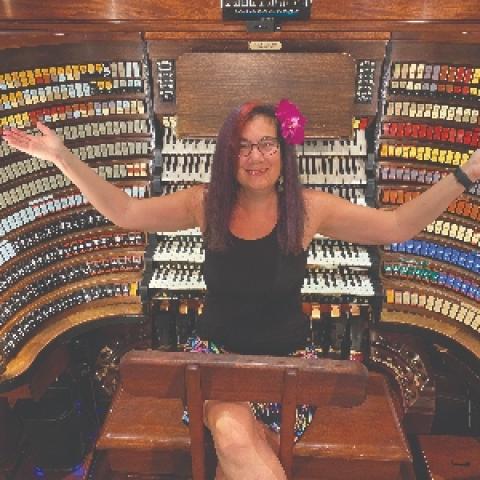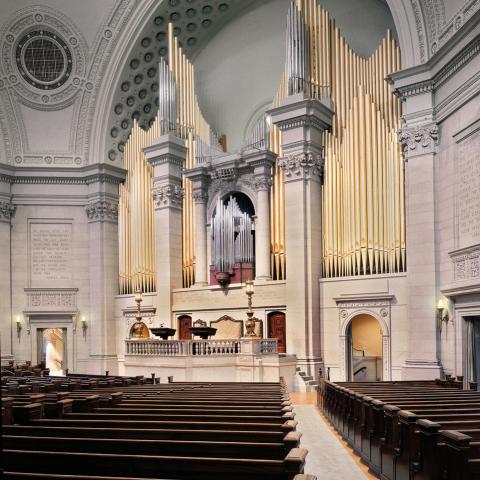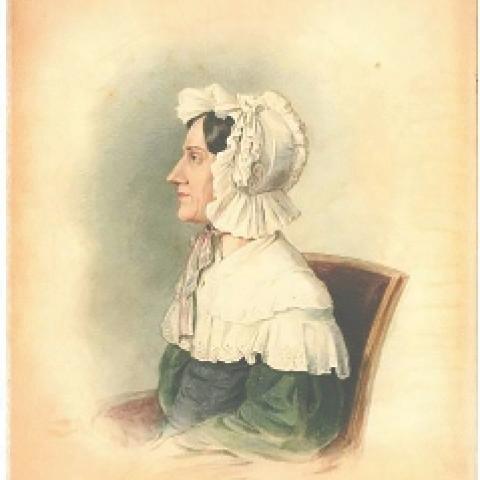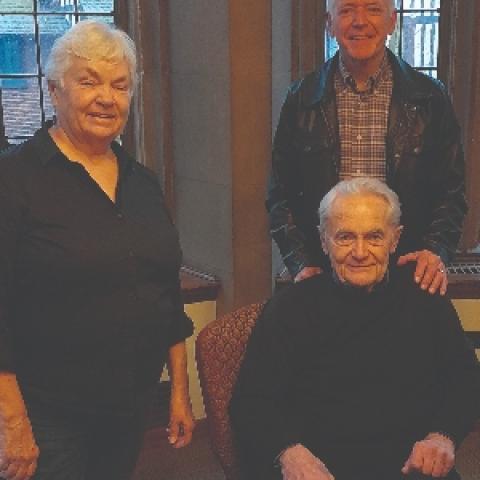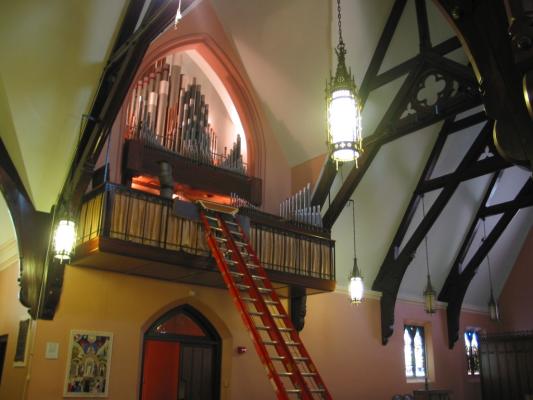
It’s all about birds.
The desk in my country office (Organ Clearing House East) is a special artifact, a three-by-eight-foot, five-quarter thick library table of quarter-sawn white oak, rescued from the basement of Saint John’s Chapel at the Episcopal Divinity School (now defunct) in Cambridge, Massachusetts. That building is home to an organ built by Holtkamp in 1956, when Charles Fisk was Holtkamp’s apprentice, when E. Power Biggs lived a few blocks away, when Daniel Pinkham was Biggs’s twenty-something protégé, and when Melville Smith, director of the Longy School of Music, was organist to the seminary. When I was twelve, I had my first organ lessons there with Alastair Cassels-Brown. My father was an alumnus from the days when it was known as the Episcopal Theological School and later taught homiletics there.
When I was running the Bishop Organ Company in the Boston area in the 1980s and 1990s, I had the care of that Holtkamp organ, the vehicle for my adolescent laboring over Bach’s Eight Little Preludes and Fugues, a few numbers from Das Orgelbüchlein, and Clérambault’s Suite du premier ton. During a service call, I scampered down the iron spiral stairs to the blower room in the basement,1 where I noticed three or four oak tabletops standing against a basement wall with a heap of lumber from the corresponding trestles. I asked the guy from the buildings and grounds department, a cheerful old ally, if the tables had any future, and he said I was welcome to take them all. I took only one, heavy as lead, covered with spiders and mold. I brought it to my workshop in Newcastle, cleaned it up, re-glued a couple joints, and put a nice dark stain and lacquer finish on it.
Sitting at that desk as I write now, I think of my father, certain that when he was a student in early 1950s, he sat at this very table laboring over arcane theological texts. He has been gone more than six years, and his ninety-sixth birthday passed a few days ago. His relationship with this oak table may be imagined, but I believe it to be true.
I look across the lawn to the Damariscotta River, a tidal estuary with the Gulf of Maine about eight miles down, and these days (early June) my view is loaded with birds. We have just put out our birdfeeders, so goldfinches, purple finches, cardinals, blue jays, and four or five varieties of sparrows are darting back and forth, and our old friend the eastern phoebe is building her nest right over my office windows. She perches on a trellis a few feet away, glancing back and forth, and flits up above to work on her solid little mud-daubed nest. She has wised up a little. For the past several years, she built her nest on the crook of a downspout just outside the front door, where she was regularly interrupted by our coming and going. Nevertheless, she persisted and raised a neat little brood of chicks right in front of our eyes. There she is again, a bit of moss in her beak and her tail twitching.
The other day I stopped at Home Depot with a springtime list. I was busy with a thousand choices of light bulbs (it is not as simple as it used to be) when I became aware of the chorus of birdcalls in the vast open spaces above the orange shelves. I recognized chipping sparrows, song sparrows, and white-throated sparrows (“Old Sam Peabody-Peabody-Peabody”), and the lovely confused tumbling call of a robin, and I wondered if they had any chance of getting back outdoors during their lives. I suppose some are trapped forever, breeding indoors, perhaps forming new species like the “hardware sparrow, the kitchen-and-bath sparrow, or ironically, the lawn-and-garden sparrow.” Will the call of the plumbing sparrow be distinct from that of the electrical sparrow?
Olivier Messiaen
When Charles-Marie Widor retired as professor of composition at the Paris Conservatoire, Paul Dukas was appointed his successor. His students included some of the greats of the organ world, including Jehan Alain, Maurice Duruflé, Jean Langlais, and Olivier Messiaen. Dukas frequently repeated to his students that they should “listen to the birds.” Presumably the idea was to keep their ears full of natural and spontaneous musical sounds, sounds that had both purpose and beauty. I guess that made them the sorcerer’s apprentices.
Olivier Messiaen grew to be both an admired composer and an ornithologist. Organists know well his devotion to birdcalls and how in his music he emulates birdcalls through the use of sophisticated combinations of mutations. His birdcalls are real, not imagined, collected from forests around the world with the help of his wife, the pianist Yvonne Loriod. Together, they recorded the calls, and he transcribed them into musical notation, amassing a collection of more than two hundred notebooks.
Messiaen was appointed professor of composition at the Paris Conservatoire in 1966 where he presided over a class of a dozen or more students each year. I recently met a student of his at a gathering of organists in New York City. We were seated next to each other with six others around a banquet table, in a large room alive with well-oiled conversation, and I was excited to hear a few stories about life as the student of such an innovative and revered composer and musician. Eager to hear more, I invited him to lunch a few weeks later.
Brian Schober, now organist of an Episcopal church in the New Jersey metropolitan area, was a member of Messiaen’s composition class from 1973 through 1976. He recalls that the class of around twenty students met in seminar three times a week. Messiaen was a kind and thoughtful mentor who was close to his students, supportive of them both personally and in class. Brian’s program was to last three years, but as the second year was coming to a close, he learned that the funding was ending. When he informed his teacher that he would be leaving, Messiaen responded by suggesting an alternative source of funds and helped him apply and receive it.
Messiaen showed his devotion to his students by arranging and attending performances of their music. In classes, he referred occasionally to his interest in birds, but he was also deeply interested in astronomy, Shakespeare, and the relationship of color to music. When listening to music, he perceived color, a concept that is often explored in literature.
One of my favorite stories is the twenty-novel saga of Captain Jack Aubrey of the Royal Navy and Stephen Maturin, the physician who travels with Jack as ship’s surgeon that serves as cover for his interest in the natural world and his activities as a naval intelligence agent. Jack plays the violin, Stephen plays the cello, and they play together in the Captain’s cabin as the various ships circle the globe.
In Post Captain, the second novel of the series, Jack has been injured in a battle and Stephen has prescribed some nasty medications. The battle was a stunning victory for the British, and as a result Jack was promoted from commander to post-captain. Newly promoted Jack and Stephen attended a party at the home of the admiral whose wife (known to Jack as “Queenie,” a sort of nanny from his youth) was showing off a recently acquired, somewhat salacious painting of an “as of yet unrepentant” Mary Magdalene:
[Jack] had gone to bed at nine, as soon as he had swallowed his bolus and his tankard of porter, and he had slept the clock round, a sleep full of diffused happiness and a longing to impart it—a longing too oppressed by languor to have any effect. Some exquisite dreams: the Magdalene in Queenie’s picture saying, ‘Why do not you tune your fiddle to orange-tawny, yellow, green, and this blue, instead of those old common notes?’ It was so obvious: he and Stephen set to their tuning, the ’cello brown and full crimson, and they dashed away in colour alone—such colour!2
Knowing that Messiaen had strong impressions of color related to music, I wonder if he ever read that passage. It is a great concept, one that would be fun to associate with the organ. What if each stop of the organ produced a different color? I know, they do, but I do not mean tone colors, I mean 8′ Navy Blue, 4′ Crimson, 22⁄3′ Aquamarine, 2′ Lilac, and 16′ Burgundy. (I guess the aquamarine doesn’t go with the others.)
Brian talked of Messiaen’s love for New Caledonia, especially the species of birds native to the island territory. While writing his opera, Saint François d’Assise, Messiaen traveled to the saint’s home of Assisi and New Caledonia to research, record, and transcribe the birds Saint Francis would have known. Bryce Canyon National Park in Utah is another place that Messiaen made a point of visiting while touring in the United States. It was fun to hear the first-hand accounts of this innovative composer, musician, improviser, teacher, and gentle man.
New York City’s Church of the Ascension is a few blocks from our apartment. It is home to a spectacular new organ built by Pascal Quoirin in Saint-Didier, France. It is one of a very few French organs in the United States, and by many times the largest. Two gorgeous cases face each across the chancel, framing a magnificent, monumental mural depicting the Ascension of Christ by John La Farge. In a sense, it is actually two organs. As one, it is a three-manual mechanical action organ with classical French registrations and brilliant Baroque choruses. As the other, it is a big four-manual French symphonic instrument with radiating tiered stop jambs. Dennis Keene, long-time organist of the church (and successor to Vernon de Tar), was influential in the planning of this unique instrument, and one of his intentions was to include all the stops that Messiaen specified in his organ music.
One of the first recitals on the new Quoirin organ was played by Jon Gillock, who studied with Messiaen at the Paris Conservatoire in 1977. Jon played lots of Messiaen’s music, taking advantage of the carefully planned organ to present that mystical music authentically. After his studies in Paris, Jon played the New York premieres of many of Messiaen’s pieces for organ, including the first performance of all Messiaen’s organ music in one series.
Messiaen was organist at Sainte-Trinité in Paris from 1931 until 1992, nearly as long as Widor played at Saint-Sulpice. The Cavaillé-Coll organ with three manuals and about sixty-five stops, built in 1869 and rebuilt twice during Messiaen’s tenure, was the workshop for his tonal experiments. Sainte-Trinité is a vast interior space with grand acoustics. I imagine that Messiaen could picture open areas in his mind’s eye as he sat at the console producing the chirps, trills, and warbles of his beloved birds. Although Church of the Ascension lacks the aural spaciousness of Sainte-Trinité, one can certainly sense the great outdoors listening to the organ in that beautifully decorated Greenwich Village landmark.
How do they do it?
The hermit thrush has the most beautiful call we hear in our yard. It sings from a hiding place in the woods (it’s not kidding about the hermit part) just as the afternoon melds into evening. I am often outside on the patio with a cocktail in one hand and barbeque tongs in the other, watching the blur of activity around the backyard bird feeders, when the hermit thrush lets loose its lovely sounds. The call of the hermit thrush has been described as a waterfall flowing backward. One enthusiast wrote, “I heard this bird call in the woods, and wanted to know what it was. I went home and Googled ‘a bird that sounds like a sad flute,’ and there it was.” It is easy to find this gorgeous call on YouTube.
One of the things that makes it special is that it is diplophonic—there are two distinct and separate tones occurring at once, kind of like a sopranino trilling didgeridoo. I have seen oscilloscope displays that show this in real time. It is a marvelous example of the beauties and complexities of nature and an important reminder of our responsibility toward our fellow inhabitants of the planet. We are the ones with the gift of reason and the ability to understand. We are the ones who can help these creatures survive or spoil everything. The fact that we have cardinals in our yard is an anomaly. Ten years ago, they did not come this far north.
Regular readers recognize that I spend a lot time writing about boats and birds when I should be writing about organs. After all, this is a journal for organists and organbuilders. But isn’t a sailboat a tool that relies on the power and sophistication of the wind, just like an organ? And aren’t birds the ultimate examples of tonal variety?
Andy Rooney, the curmudgeonly commentator on Sixty Minutes for about as long as Widor was organist at Saint-Sulpice, once wrote a column about nuts, those people who are nuts about one particular thing. We all know them, in fact, most of us are nuts about pipe organs. It is funny how many organ nuts are also railroad nuts, especially steam railroads. Bird nuts are equally nuts.
Kenn Kaufman, author of the Kaufman Field Guides, is one of Wendy’s clients, and we have spent many days in the woods around our house with him and his wife Kimberly, watching and listening for birds, insects, and any other little feature of the natural world. When Kenn was a teenager, his parents agreed to let him hitchhike the United States to pursue a “Big Year,” a race to see as many different species of birds as possible. His memoir Kingbird Highway, published by Houghton-Mifflin in 1997, tells the story of racing back and forth across the country to look for the specific hard-to-find bird in the most out-of-the-way places, places like a dump in Texas to see a Mexican Crow. Really. Birding with Kenn is like staring at a blank sky, listening to him name off all the birds he is seeing. He really is seeing them. His big year was around 675 species. The current big year record in the American Birding Association is 836 species, set in 2016 by Australian John Wiegel. The worldwide big year record is 6,852 species, set by Arjan Dwarshuis of the Netherlands. Now that’s nuts.
The art of birding allows one to count hearing a song as a “sighting.” Just as Messiaen could see colors as he heard music, we can populate the woods around us by “sighting” the songs of the birds. Once you know a call, you hear it all the time. The calls of robins and goldfinches are similar, little successive trills of random sounding notes, but the goldfinch is something like the robin “up a sixth.” A raven looks like a punk-rock crow, and its deep rasping call sounds like a crow with a terrible attitude, a crow you would not want to meet in a dark alley.
Over at least five centuries, organbuilders have experimented with the shapes, scales, and materials of organ pipes. We who spend lots of time “up close and personal” with organ pipes, like when we are tuning, get to know intimately the differences between a Gemshorn and a Dulciana, a Trumpet and a Cornopean, an Oboe and a Flügel Horn, a Gedeckt and a Rohrflöte. Sitting in a pew, listening to the organ, I get pictures in my head of the little choo-choo train tops of the resonators of the English Horn, the tapered caps of the Koppelflöte, or the heavy lead of the Stentor Diapason. Their tones are as distinct as the differences between the calls of the greater black back gull and the great blue heron.
Learning to identify those “organ calls” is at the center of the art of registration. Imitating the natural world, we have been given the gift of tonal variety. Use it with care, cunning, love, and good taste.
Random associations
I am obliged to admit that while I was writing, a chirp from the background in my laptop lured me across to Facebook where a friend was making a sassy remark about something I wrote. I would not have confessed, but I stumbled on a brilliant video of Cecilia Bartoli singing “Agitate da due venti” from Vivaldi’s La Griselda. There must have been a whiz of a soprano student at the school where Vivaldi taught. If there was ever a magical display of tone production, variety of color, and management of wind, it was this woman singing this aria. Go on. I dare you. In fact, I require you. Send me a note and tell me what you think. It’s why we make music: https://www.youtube.com/watch?v=H4It44mYw2I.
Notes
1. These days, scampering isn’t what it used to be.
2. Patrick O’Brian, Post Captain, W. W. Norton, 1990, page 421.


